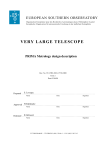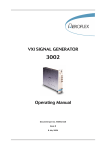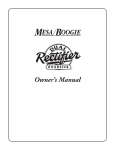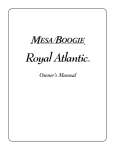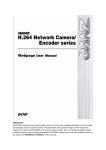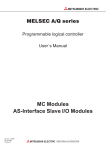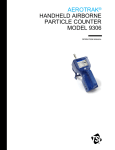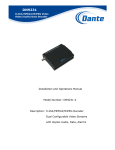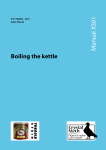Download USER`S MANUAL for Models LM, HM, LC and HC
Transcript
PORTER MASS FLOWMETERS AND FLOW CONTROLLERS FOR LIQUIDS USER’S MANUAL for Models LM, HM, LC and HC FM-653 Rev. B 8/02 “Quick-Start” Installation Instructions Note: The instructions below contain procedures for the installation and start-up of your Porter Instrument Mass Flowmeter and Flow Controller for Liquids. It is recommended these instructions and the entire User’s Manual be read and understood before performing any operation. Failure to do so could result in serious injury and/or damage to the equipment. The original shipping container in which your Mass Flowmeter/Mass Flow Controller was received should not be discarded in case reshipment is necessary. Before installing your Mass Flowmeter/Flow Controller, please confirm the following: ■ Flow rate. ■ Process fluid. ■ Upstream and downstream operating pressures. ■ Output signal. ■ Confirm your operating conditions are within the design parameters of the flowmeter/flow controller. ■ Ensure the piping system is clean. Install upstream filtration to deliver particulate-free liquid to the flowmeter/flow controller. ■ Install the flowmeter/flow controller in-line. Tighten the process connections (i.e. fittings) in accordance with the instructions of the fitting manufacturer. ■ Apply power to the flowmeter/flow controller and allow a thirty (30) minute warm-up and stabilization period. This may be done with or without liquid flow. Warning: Accuracy degradation will occur if the flowmeter/flow controller is used prior to being properly warmed-up. ■ Your flowmeter/flow controller is now ready for start-up. PORTER INSTRUMENT COMPANY, INC. 245 TOWNSHIP LINE RD P.O. BOX 907 HATFIELD, PA 19440-0907 USA [215] 723-4000 • FAX [215] 723-2199 TABLE OF CONTENTS Section 1: Introduction General Description. . . . . . . . . . . . . . . . . . . . . . . . . . . . . Principle of Operation . . . . . . . . . . . . . . . . . . . . . . . . . . . Flow Controller . . . . . . . . . . . . . . . . . . . . . . . . . . . . . . . . . Control Valve. . . . . . . . . . . . . . . . . . . . . . . . . . . . . . . . . . . Electronics. . . . . . . . . . . . . . . . . . . . . . . . . . . . . . . . . . . . . Liquid Conversion Factors . . . . . . . . . . . . . . . . . . . . . . . Model Number and Description . . . . . . . . . . . . . . . . . . page 1 page 1 page 1 page 1 page 1 page 2 page 2 Section 2: Installation Receipt of Equipment . . . . . . . . . . . . . . . . . . . . . . . . . . . Return Shipment . . . . . . . . . . . . . . . . . . . . . . . . . . . . . . . Service . . . . . . . . . . . . . . . . . . . . . . . . . . . . . . . . . . . . . . . . Mounting . . . . . . . . . . . . . . . . . . . . . . . . . . . . . . . . . . . . . . Filling of the Flow Controller . . . . . . . . . . . . . . . . . . . . . In-line Filter . . . . . . . . . . . . . . . . . . . . . . . . . . . . . . . . . . . Process Connections . . . . . . . . . . . . . . . . . . . . . . . . . . . . Electrical Connections . . . . . . . . . . . . . . . . . . . . . . . . . . . Supply Pressure . . . . . . . . . . . . . . . . . . . . . . . . . . . . . . . . System Purging . . . . . . . . . . . . . . . . . . . . . . . . . . . . . . . . . Seals. . . . . . . . . . . . . . . . . . . . . . . . . . . . . . . . . . . . . . . . . . page 3 page 3 page 3 page 3 page 3 page 5 page 5 page 5 page 5 page 5 page 5 Section 3: Operation General . . . . . . . . . . . . . . . . . . . . . . . . . . . . . . . . . . . . . . . Power and Warm-up. . . . . . . . . . . . . . . . . . . . . . . . . . . . . Zeroing. . . . . . . . . . . . . . . . . . . . . . . . . . . . . . . . . . . . . . . . Start-up . . . . . . . . . . . . . . . . . . . . . . . . . . . . . . . . . . . . . . . Operating Conditions . . . . . . . . . . . . . . . . . . . . . . . . . . . page 6 page 6 page 6 page 6 page 6 Section 4: Maintenance General . . . . . . . . . . . . . . . . . . . . . . . . . . . . . . . . . . . . . . . Flowmeter . . . . . . . . . . . . . . . . . . . . . . . . . . . . . . . . . . . . . Flow Controller . . . . . . . . . . . . . . . . . . . . . . . . . . . . . . . . . Control Valve. . . . . . . . . . . . . . . . . . . . . . . . . . . . . . . . . . . Restriction for Liquids . . . . . . . . . . . . . . . . . . . . . . . . . . . Calibration. . . . . . . . . . . . . . . . . . . . . . . . . . . . . . . . . . . . . PC Board Layout . . . . . . . . . . . . . . . . . . . . . . . . . . . . . . . . page 7 page 7 page 7 page 7 page 8 page 8 page 8 Section 5: Troubleshooting General . . . . . . . . . . . . . . . . . . . . . . . . . . . . . . . . . . . . . . . page 9 Troubleshooting . . . . . . . . . . . . . . . . . . . . . . . . . . . . . . . . page 9 Section 6: Safety Information for the Return of Mass Flowmeters/ Mass Flow Controllers General Information. . . . . . . . . . . . . . . . . . . . . . . . . . . . . page 11 Declaration of Contamination. . . . . . . . . . . . . . . . . . . . . page 11 Return Shipment . . . . . . . . . . . . . . . . . . . . . . . . . . . . . . . page 11 Section 7: Certificate of Warranty Certificate of Warranty . . . . . . . . . . . . . . . . . . . . . . . . . . . page 12 Appendix 1: Dimensional Drawings Model LM Flowmeter. . . . . . . . . . . . . . . . . . . . . . . . . . . . page 13 Model HM Flowmeter . . . . . . . . . . . . . . . . . . . . . . . . . . . page 14 Models LC and HC Flow Controllers . . . . . . . . . . . . . . . page 15 Appendix 2: Hook-up Diagrams Models LM and HM Flowmeters . . . . . . . . . . . . . . . . . . Models LC and HC Flow Controllers . . . . . . . . . . . . . . . Electrical Connector. . . . . . . . . . . . . . . . . . . . . . . . . . . . . Interconnecting Cable Assembly . . . . . . . . . . . . . . . . . . Electrical Connector Assembly. . . . . . . . . . . . . . . . . . . . page 16 page 17 page 18 page 18 page 19 SECTION 1 - INTRODUCTION General Description The Porter Instrument Mass Flowmeter and Flow Controller are accurate devices for measuring and/or controlling liquid flows. The flowmeters and flow controllers can handle flows to 0 - 1000 grams/hour water. When supplying a flow controller, the control valve is welded to the flowmeter. Principle of Operation The Porter Instrument Mass Flowmeter and Flow Controller for Liquids include a 316“L”SS, through-flow sensing tube. The sensing tube has an inner diameter (I.D.) of approximately .039” and contains no flow obstructions. Above the center of the sensing tube is a patented heater/sensor design. The sensor measures the temperature differential across upstream and downstream legs of the sensing tube by means of a thermopile. The resulting electrical signal is an accurate measurement of mass flow. Flow Controller Flow control is achieved by coupling a control valve to the flowmeter. As previously mentioned, the control valve is welded to the flowmeter. A purge connection is included on the top of the valve stem. The electronic control circuitry is incorporated on the printed circuit (PC) board assembly contained in the flowmeter. Control Valve The standard control valve is a normally-closed solenoid valve. A magnetic field, created by the coil assembly, lifts the internal valve assembly off the orifice allowing flow to pass. The orifice is a removable component. Electronics The housing of the flowmeter is protected for radio frequency interference (RFI) and electromagnetic interference (EMI). The circuitry on the PC board has roll-off capacitors for additional RFI and EMI suppression. Where high levels of RFI and/or EMI are present, shielded cables with twisted pairs are recommended. The PC board assemblies are manufactured with surface-mount devices (SMD). External connection to the PC board is made using an eight (8)-pin DIN connector. A ±15 Vdc power supply is required for both the flowmeter and flow controller. One of the following output signals is available: 0-5 Vdc with 2K ohm minimum load 4-20 mAdc (non-floating/ground-referenced) The output signal type must be specified at time of order placement. 1 Liquid Conversion Factors The general formula for determining the relationship between the output signal and the mass flow rate reads: Vsignal = k • Cp • φm • [1 - (b / λ+ c) • Cp • φm] where: Vsignal = output signal k = calibration constant Cp = heat capacity at constant pressure of the fluid φm = mass flow b = meter constant λ = thermal conductivity of the fluid c = meter constant A conversion factor must be used if the flowmeter or flow controller is not used on the liquid for which it was calibrated. The formula for determining the conversion factor is as follows: φm1 = Cf • φm2 where: Cp2 [1 - (b / λ2 + c) • Cp2 • φm2] Cf = where: Cp1 Cp2 λ1 λ2 = = = = Cp1 [1 - (b / λ1 + c) • Cp1 • φm1] heat capacity of the calibration liquid heat capacity of the process fluid thermal conductivity of the calibration liquid thermal conductivity of the process fluid For application of this formula, please consult Porter Instrument. Model Number and Description To order, specify: ■ Complete Model Number (see below) ■ Liquid Type - Include Density, Heat Capacity, Thermal Conductivity, Viscosity and Boiling Point ■ Maximum Flow Rate ■ Upstream and Downstream Pressure ■ Operating Temperature LM A - 05 - 2 - X - 0 Elastomers 0 . . . None (Flowmeters) Base Model Max. Flow (H2O) 2 . . . Kalrez® (Flow Controllers & LM . . Flowmeter . . . . . .100 grams/hour Control Valve) HM . . Flowmeter . . . . . .1000 grams/hour LC . . . Flow Controller . .100 grams/hour Valve Style HC. . . Flow Controller . .1000 grams/hour C . . . Normally Closed (Flow Controllers LV . . . Control Valve . . . .1000 grams/hour & Control Valve) E . . . Electrically-Coupled Stand-Alone Control Valve (Models HM, LM & Model Revision LV only) (Factory-Specified) X . . . No Valve (Flowmeters) Output 00 . . None (Model LV only) 05 . . 0-5 Vdc 42 . . 4-20 mAdc Kalrez® - DuPont Dow Elastomers L.L.C. 2 Fitting Size and Type 2 . . . 1/8" Compression 3 . . . 1/8" Male Metal Gasket Face Seal 4 . . . 1/4" Compression (Models HM, HC & LV only) 8 . . . .1/4" Male Metal Gasket Face Seal SECTION 2 - INSTALLATION Receipt of Equipment Carefully check the shipping container for damage incurred during shipment. Should the container be damaged, notify the carrier immediately. Also, report the damage to Porter Instrument. Remove the packing list. Carefully unpack the equipment and inspect the contents against the packing list and for any damaged or missing parts. The original shipping container in which your Mass Flowmeter/Mass Flow Controller was received should not be discarded in case reshipment is necessary. Return Shipment Before returning your flowmeter or flow controller to the factory, contact Porter Instrument’s Customer Service Department for a return authorization (RA) number. Include with the returned equipment: 1. A cover letter detailing the requested repair. 2. A completed Declaration of Contamination form. To safeguard the repair personnel, notify Porter Instrument if toxic and/or dangerous fluids have been used with the returned equipment. This enables Porter Instrument to take sufficient precautionary measures. Also, the equipment must be cleaned of the toxic and/or dangerous fluids. Properly pack the equipment, using the original shipping container whenever possible. Service If the flowmeter or flow controller is not properly serviced, serious personal injury and/or damage to the equipment could result. It is important that servicing be performed by trained and qualified service personnel. Mounting The Mass Flowmeter and Flow Controller for Liquids are attitude insensitive. This is due to the through-flow measurement design coupled with the very low temperature increase in the heater. When using a mass flow controller, the purge connection on the control valve must be pointed up to successfully bleed entrapped gas bubbles from the valve. Avoid installation in close proximity of mechanical vibration and/or strong heat sources. Filling of the Flow Controller Although the unit is sensitive to gas in the sensing tube, the start-up procedure is simple. All entrapped gas bubbles should be removed by bleeding them out the purge connection on the control valve. Mass flow measurement and control of fluids can be degraded if bubbles are present in the liquid or trapped in the liquid flow control device. 3 There are two ways for bubbles to become a problem. When the instrument is filled. In the flow controller, bubbles can get trapped in the valve. These can easily be removed by opening the purge connection on top of the valve. A flowmeter, having no valve, should not trap bubbles. Initial filling of the system should be straightforward. If the liquid contains dissolved gasses. This usually happens when the liquid is pressurized with a gas such as Helium or Nitrogen. The pressurizing gas gets absorbed into the liquid the same as carbon dioxide is absorbed into soda water. These bubbles can then effervesce in the sensor and disrupt the flow measurement. Bubbles collecting in the valve can also cause erratic performance. To mitigate this: 1. Keep the supply pressure as low as possible which will reduce the absorption rate. 2. Keep the liquid-gas interface area as small as possible which will reduce the absorption rate. 3. If gas does get absorbed, drain the supply liquid and refill periodically or reduce the supply pressure and agitate the liquid to drive off the gas; just like shaking a bottle of soda drives off the CO2. A vacuum can also pull dissolved gasses from solution. When a liquid flows through an orifice such as the one in the flow controller valve, the pressure drops as shown in the diagram below. If the inlet pressure and outlet pressure are such that the drop brings the liquid below its vapor pressure then bubbles of vapor can form. These vapor bubbles can then be entrained in the liquid leaving the flow controller. To prevent this, a capillary restrictor can be added to the circuit which will raise the outlet pressure at the orifice so that the drop does not fall below the vapor pressure. The drop through the capillary will be linear without the big dip seen in an orifice. It may be necessary to then increase the inlet pressure to achieve the flow rate desired. After filling the unit, allow a thirty (30) minute warm-up and stabilization period. Pressure Diagram 4 In-line Filter Although the process fluids and piping should be particulate-free, it is recommended to install an in-line filter upstream of the unit. If reverse flow is possible, a downstream check valve is also recommended. Process Connections The Porter Instrument Liquid Mass Flowmeters and Flow Controllers are available with 1/8" compression fittings, 1/4" compression fittings (Models HM, HC and LV only), 1/8" male metal gasket face seal fittings or 1/4" male metal gasket face seal fittings. For leak-tight installation of units with compression fittings, ensure no particulates are present on the process tubing, fittings or ferrules. Insert the tube to the shoulder of the fitting body. Tighten the nut finger-tight and, while holding the unit, wrench-tighten the nut sufficiently to prevent leakage. For face seal fittings, exercise caution so as not to damage the face seal sealing surfaces. Whether using compression or face seal fittings, refer to the applicable fitting manufacturer’s data for specific recommendations regarding installation and tightening. Electrical Connections Porter Instrument recommends using interconnecting cables assembled at the factory. These cables contain the required electrical connectors allowing hook-up between the flowmeter or flow controller and the secondary electronics. Where high levels of EMI and/or RFI are present, contact Porter Instrument. Supply Pressure Do not apply pressure until electrical connections are made. When applying pressure to the system, increase pressure gradually to avoid pressure surges. The maximum allowable operating pressure for both the mass flowmeter and mass flow controller is 1500 PSIG. System Purging In systems handling corrosive or reactive fluids, purging with an inert gas is strongly recommended. When piping is exposed to air, the introduction of a corrosive or reactive fluid could cause a chemical reaction causing the piping and/or the flowmeter/flow controller to clog or corrode. Purging is also strongly recommended to remove such fluids before shutting the system down. Seals The flowmeter has no internal seals, while the flow controller has Kalrez elastomers in the control valve. Each application should be evaluated by the user to ensure material compatibility with the process fluid. 5 SECTION 3 - OPERATION General The Porter Instrument Mass Flowmeter and Flow Controller for Liquids are designed to measure and/or control low flow liquid applications. The PC board, housed in the flowmeter, contains the control electronics required to drive the control valve. If, at a later stage, a control valve is required, it may be added to the existing flowmeter. Both the flowmeter and flow controller are powered with ±15 Vdc. Power and Warm-up Before introducing power, confirm the unit is connected in accordance with the hook-up diagram in the Appendix. Check the plumbing connections for leak-tightness. Introduce power and allow a thirty (30) minute warm-up and stabilization period. After purging the system with an inert gas, introduce the process fluid to the unit (refer to Section 2 - System Purging). After the warm-up and stabilization period and with no flow through the unit, check the output signal. The output signal should be approximately 0.2%. Zeroing All flowmeters and flow controllers are factory-calibrated to the customer’s application. The following procedure is for readjustment only. After the unit has warmed-up and stabilized and with no liquid flow, the output signal should read approximately 0.2%. For flow controllers, the output should be checked with a setpoint of zero. The electronic circuitry contains a threshold to prevent negative zero drift. When an adjustment is required, confirm the offset to be positive and adjust the zero potentiometer, marked “L”, to give an output signal of approximately 0.2% (.010 Vdc or 4.03 mAdc, depending upon output signal type). Start-up Confirm the piping is clean, the fluid is adequately filtered and the system has been leak-tested and purged with an inert gas. Introduce liquid flow and adjust the setpoint to approximately 10%. Avoid pressure surges and gradually bring the unit up to its operating conditions. Prevent pulsating and reverse flow. Operating Conditions Each unit has been calibrated and adjusted for the customer’s application. When using a flow controller in a system with varying pressures, valve control could fluctuate due to the valve’s orifice. 6 SECTION 4 - MAINTENANCE General No routine maintenance is required. When cleaning is necessary, purge the system with an inert gas (refer to Section 2 - System Purging) and remove the unit from the system. Flush the unit in both directions for five (5) minutes with a solvent. If cleaning a flow controller, confirm the solvent is compatible with the internal Kalrez elastomers. Thoroughly dry the unit with a clean, dry inert gas. For maintenance instructions, refer to the flowmeter and control valve sections which follow. Flowmeter The Liquid Mass Flowmeter is, essentially, a through-flow, 316“L”SS sensing tube having no obstructions in the flow path. There are no parts to be cleaned separately. Flow Controller The Liquid Mass Flow Controller can be supplied either as a flowmeter with an integral control valve or as a separate flowmeter and control valve. In both cases, the control circuitry is included on the PC board in the flowmeter. Control Valve The control valve may be field-disassembled by the user for cleaning and servicing. The valve components may be cleaned with a solvent or be ultrasonically cleaned. To disassemble the control valve, proceed as follows: 1. Disconnect the electrical connector from the unit. 2. Unscrew the valve stem nut. 3. Lift the valve assembly carefully up from the base. 4. Unscrew the set screw for the orifice. 5. Remove the orifice and orifice holder. 6. Remove the plunger assembly. Clean the disassembled parts. Reassemble the control valve in reverse order. It is recommended to replace the O-ring prior to reassembly. After reassembling the control valve, it is recommended to check the control characteristics of the control valve. This can be done by using a separate variable 15 Vdc power supply source. Proceed as follows: 1. Electrically disconnect the control valve from the PC board assembly. 2. Electrically connect the control valve to the power supply. 3. Introduce flow to the unit. 4. Gradually increase the valve drive voltage using the power supply. 5. The control valve should open at 7 (±3) Vdc. 6. The control valve should be fully opened at 9 (±1.5) Vdc. If the control valve does not operate within the voltage levels stated, disassemble the control valve and adjust the orifice to the proper position. Reassemble and retest. Repeat the above procedure until the voltage falls within the stated levels. 7 Restriction for Liquids Please contact the factory for the viscosity limits of the flowmeter or regarding flow controller applications handling fluids having a viscosity greater than 15 centistokes. Calibration All Porter Instrument’s Liquid Mass Flowmeters and Flow Controllers are factorycalibrated. The following procedure pertains to recalibration only. The calibration procedure requires the use of a digital voltmeter (DVM) or ammeter (depending upon the type of output signal) and an accurate calibration device. Proceed as follows: 1. Apply power to the system and allow approximately 60 minutes for warm-up and stabilization. 2. Introduce liquid flow and check system operation. 3. Remove the flowmeter’s cover to gain access to the PC board potentiometers. 4. Connect the DVM/ammeter to the output signal. 5. Step Set Liquid Flow Adjust Flow Signal Output (% of full scale) Trimpot 0 - 5 Vdc 4 - 20 mAdc A* 0 L 0.010 4.03 B* 100 H 5.000 20 C* 50 M 2.500 12 * = This adjustment must be done at a no-flow condition. 6. Repeat steps 5A - 5C until the deviation between the adjusted and desired values is less than 0.5% of the full scale value. Note: While repeating steps 5 - 6, be advised: ■ Potentiometers “H” and “M” can be adjusted without shifting the setting of potentiometer “L”. ■ Adjusting potentiometer “L” results in a corresponding shift in the setting of potentiometers “H” and “M”. ■ Potentiometer “M” can be adjusted without shifting the setting of potentiometers “L” and “H”. PC Board Layout P1: P2: P5: } Factory-adjusted P7: Controls the output differentiating network. This determines the dynamic response characteristic of the output signal. Factory-adjusted. P8: Controls the derivative action of the control circuit. Factory-adjusted. 8 SECTION 5 - TROUBLESHOOTING General For correct troubleshooting of the Mass Flowmeter and Flow Controller for Liquids, it is recommended to remove the unit from the process line and evaluate it without any liquid flow. In situations where the unit is dirty, this will be obvious upon removal from the system. Remove the cover of the housing and confirm the valve lead connector (if the unit is a flow controller) is properly attached. Troubleshooting Symptom Possible Cause Action No output signal No ±15 Vdc power Check power supply and cable connection PC board failure Return to factory Supply pressure too high or differential pressure across unit too high Lower supply pressure Valve clogged and/or contaminated Connect a variable 15 Vdc power supply to the valve and slowly raise voltage while supply pressure is on. Valve should open at 7 Vdc (±3 Vdc). If not, clean valve internals and adjust valve (qualified personnel only) Sensor failure Return to factory PC board failure Return to factory Sensor failure Return to factory Filter contaminated Clean filter Flowmeter clogged and/or contaminated Clean flowmeter Valve clogged and/or contaminated Clean valve Internal valve damage Replace valve internals and adjust valve Unit being used on application for other than which it was calibrated Try unit at original calibration conditions Maximum output signal Output signal much lower than setpoint signal or desired flow 9 Toubleshooting (Cont’d) Symptom Possible Cause Action Oscillation Supply pressure/differential pressure too high Lower supply pressure Pressure regulator is oscillating Replace pressure regulator Valve stem and/or valve internals damaged Replace damaged parts and adjust valve Valve leaks due to damaged valve plunger or dirt in/on orifice Clean orifice and/or replace valve plunger Supply pressure excessively high or low Apply correct supply pressure Entrapped gas bubbles Remove entrapped gas (refer to Section 2 Mounting and Filling of the Flow Controller) Pulsations caused by pump in system Contact factory to dampen output signal Output signal is stable and flow is excessively high Fold-over and lock-up by controlling system oversized orifice or pressure differential excessive Adjust setpoint to zero for five (5) minutes and increase setpoint slowly to 10% and above No control possible Viscosity too high (> 15 centistokes) Misapplication Flow at zero setpoint Output signal fluctuates 10 SECTION 6 - SAFETY INFORMATION FOR THE RETURN OF MASS FLOWMETERS/MASS FLOW CONTROLLERS General Information Porter Instrument Co., Inc. bears the responsibility for the health and safety of its employees. This responsibility includes the repair personnel performing the repair and/or recalibration of a Mass Flowmeter/Mass Flow Controller returned by the user. With this in mind, Porter Instrument Co. requests a Declaration of Contamination form be completed and included with the Mass Flowmeter/Mass Flow Controller when returned. Also suggested is the inclusion of a Material Safety Data Sheet (MSDS) for the process fluid in question. Declaration of Contamination It is imperative the repair personnel, prior to initiating the repair/recalibration work, be informed regarding the condition of the returned unit and on what process fluid the unit was used. The Declaration of Contamination form serves this purpose. A Completed Declaration of Contamination form must accompany the returned unit, otherwise no repair/recalibration work will be performed. Return Shipment Before returning your Mass Flowmeter/Mass Flow Controller to the factory, contact Porter Instrument’s Customer Service Department for a return authorization (RA) number. In addition to the completed Declaration of Contamination form, include a cover letter detailing the requested repair. This enables Porter Instrument to take sufficient precautionary measures while expeditiously repairing/recalibrating the returned unit. Properly pack the Mass Flowmeter/Mass Flow Controller, using the original shipping container whenever possible. 11 SECTION 7 - CERTIFICATE OF WARRANTY THIS WARRANTY IS GIVEN IN PLACE OF ALL OTHER WARRANTIES, EXPRESS OR IMPLIED, OF MERCHANTABILITY, FITNESS FOR A PARTICULAR PURPOSE, OR OTHERWISE. NO PROMISE OR STATEMENT MADE BY ANY REPRESENTATIVE OR AUTHORIZED DEALER OF PORTER INSTRUMENT CO., INC. SHALL CONSTITUTE A WARRANTY BY PORTER INSTRUMENT CO., INC. PORTER INSTRUMENT CO., INC. ASSUMES NO LIABILITY FOR USE OF THIS EQUIPMENT. Porter Instrument Co., Inc. warrants this equipment to be free from defects in workmanship and materials, when used in accordance with applicable specifications and with appropriate maintenance, for one (1) year from date of delivery to the customer, unless otherwise specified in writing. Equipment which malfunctions may be returned, shipment prepaid, to Porter Instrument Co., Inc. for test and evaluation. Equipment determined to be defective and in warranty will be repaired or replaced at no charge to the customer. Equipment out of warranty will be evaluated, and if the equipment does not meet original specifications and calibration, the customer will be notified of the costs before proceeding with repair or replacement. Repaired equipment will be warranted ninety (90) days from date of delivery to customer or for the balance of the original warranty, whichever is longer. Failures due to shipping damage, accident, misuse, improper mechanical or electrical installation or operation, or internal clogging or corrosion due to use of contaminated fluids or inadequate system purging are excluded from warranty coverage. Porter Instrument Co., Inc.’s obligation for breach of this warranty, or for negligence or otherwise, shall be strictly and exclusively limited to the repair or replacement of the equipment. This warranty shall be void as to any equipment on which the serial number, if applicable, has been altered, defaced, or removed. Porter Instrument Co., Inc. shall under no circumstances be liable for incidental or consequential damages. No other promise or statement about the equipment by any representative or authorized dealer of Porter Instrument Co., Inc. shall constitute a warranty by Porter Instrument Co., Inc. or give rise to any liability or obligation of Porter Instrument Co., Inc. 12 APPENDIX 1: DIMENSIONAL DRAWINGS Model LM Flowmeter M4 (2 places) Fitting Type 1/8” compression 1/8” male metal gasket face seal 1/4” male metal gasket face seal A 55 B 126 H 155 K 60 L 42 M 11 T 50 U 5 V 11.5 55 124 155 60 42 11 50 5 11.5 55 124 155 60 42 11 50 5 11.5 Note: Dimensions stated in millimeters (mm) Dimensions subject to change without notice 13 APPENDIX 1: DIMENSIONAL DRAWINGS Model HM Flowmeter M4 (2 places) Fitting Type 1/8” compression 1/4” compression 1/8” male metal gasket face seal 1/4” male metal gasket face seal A 55 55 B 126 127 H 155 155 K 85 85 L 45 45 M 11 11 T 50 50 U 5 5 V 14 14 55 124 155 85 45 11 50 5 14 55 124 155 85 45 11 50 5 14 Note: Dimensions stated in millimeters (mm) Dimensions subject to change without notice 14 APPENDIX 1: DIMENSIONAL DRAWINGS Models LC and HC Flow Controllers (Model LC illustrated) B M4 (2 places) M5 (2 places) Fitting Type 1/8” compression 1/4” compression (available on Model HC only) 1/8” male metal gasket face seal 1/4” male metal gasket face seal Note: Dimensions stated in millimeters (mm) Dimensions subject to change without notice 15 B 170 172 169 169 H 155 155 155 155 APPENDIX 2: HOOKUP-DIAGRAMS Models LM and HM Flowmeters VOLTAGE MODE CURRENT MODE 16 APPENDIX 2: HOOK-UP DIAGRAMS Models LC and HC Flow Controllers VOLTAGE MODE / Heater common 5 CURRENT MODE / Heater common 5 17 APPENDIX 2: HOOK-UP DIAGRAMS Electrical Connector Interconnecting Cable Assembly / Heater common / Heater common 18 APPENDIX 2: HOOK-UP DIAGRAMS Electrical Connector Assembly 19 PORTER INSTRUMENT COMPANY, INC. 245 TOWNSHIP LINE RD. P.O. BOX 907 HATFIELD, PA 19440-0907 USA [215] 723-4000 / FAX [215] 723-2199























